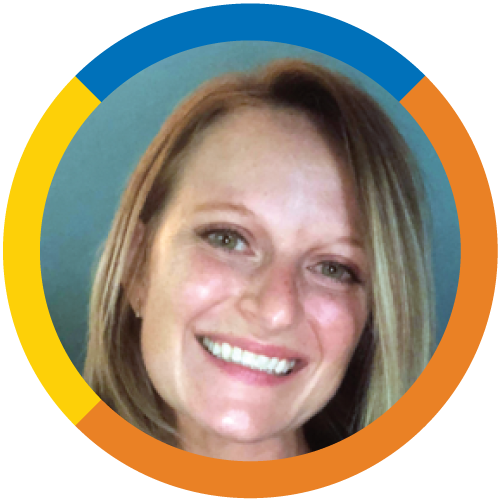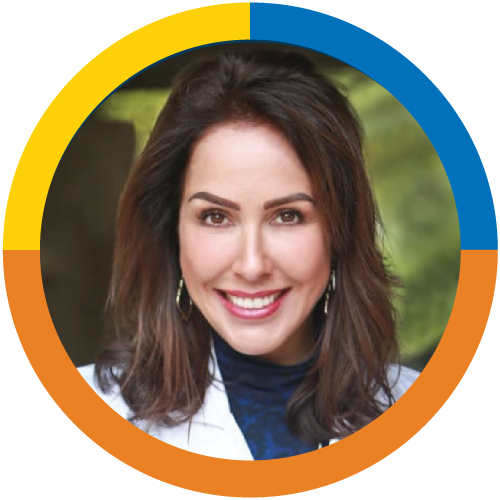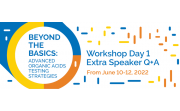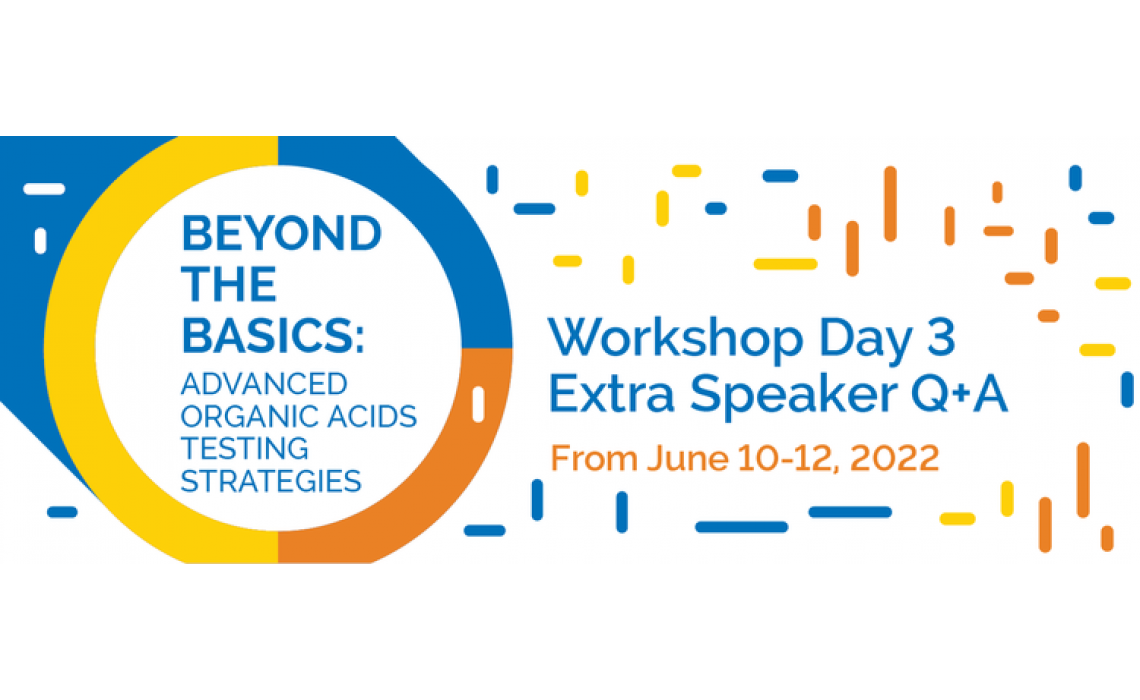MYCOTOXIN, GLYPHOSATE & IGG: Q&A WITH ELENA VILLANUEVA, DC, SHANHONG LU, MD, WILLIAM SHAW, PHD & LINDSAY GODDARD, RD
The following Q+A is a grouping of responses from the Day 3 workshop presentations. Click each presentation title to expand the answers from each speaker.
The material contained within this article is not intended to replace the services and/or medical advice of a licensed healthcare practitioner, nor is it meant to encourage diagnosis and treatment of disease. It is for educational purposes only. Any application of suggestions set forth in the following portions of this article is at the reader's discretion and sole risk. Implementation or experimentation with any supplements, herbs, dietary changes, medications, and/or lifestyle changes, etc., is done so at your sole risk and responsibility.
DAY 3 Q+A: TOXIN EXPOSURE AND MORE

WILLIAM SHAW, PHD
Organic Acids and Mycotoxins: Correlations With Mold in Various Chronic Illnesses | Speaker Panel
Q: Why not add Volatile Organic Compounds to your MycoTOX Profile?
A: Volatile organics would have to be extracted by a different method than mycotoxins.
Q: Farmed chickens are fed corn. Do you think chicken meat may contain mycotoxins?
A: Very likely, unless corn feed is tested for mycotoxins.
Q: Do you use 240 mg/kg/day to calculate the dosage of cholestyramine for children or how do you calculate pediatric dosage? Would you use cholestyramine in infants as well?
A: The usual dosage in children (0-17 years) is 240 mg/kg of body weight per day of anhydrous cholestyramine resin taken in 2 to 3 divided doses. Most children won’t need more than 8 grams per day.
Q: Which medication or herbal combinations are best for both Candida and Aspergillus simultaneously?
A: The big problem is that there is a lack of published studies for herbals used as antifungals. Amphotericin and itraconazole have been used for both Candida and many molds, but there are resistant strains that require other drugs.
Q: For children with liver toxicity due to Sporanox, how do you approach that? Maybe half dose for twice as long? Do you have ideas for alternatives for Itraconazole/ Sporanox?
A: I would recommend oral nystatin, if there is evidence of liver toxicity with Sporanox. This is because nystatin is not absorbed from the GI tract.
Q: Why do some people get so sick when exposed to mold? Could it be the genetic component HLA gene possibly?
A: All of the mycotoxins are extremely toxic and may be fatal. The dose of mycotoxin is likely the main factor determining the degree of illness. Neil Nathan, MD states that he found HLA testing of little use in mold treatment.
Q: What may be the other likely causes of mold exposure for adults apart from damp houses?
A: Food or water damaged buildings are the most common causes of mold exposure. Food is unlikely source in USA and EU where food testing is required for foods commonly mold contaminated.
Q: I was told that you should not use bleach because it causes the mold spores to open up and release the mycotoxins and that hydrogen peroxide is a better option. Can you comment on this?
A: Chlorine bleach can help eliminate mold on hard non-porous surfaces like sinks, bathtubs, tiles, or glass. This is because the roots of the mold do not penetrate through this surface and so it is easily wiped off.
However, when mold grows on a porous material like wood or drywall, it spreads its roots deep into the material to reach more nutrients. So when you apply bleach to such a surface, you are merely changing the mold’s color on the surface. Bleach quickly dries off on the surface and will not reach into the deeper part of the material to the mold’s root. So, in a few days or weeks, the mold regains its color and grows back to become even worse than it was before you applied the bleach.
I would suspect that hydrogen peroxide would also be ineffective on these porous materials which is why replacement of these materials is the most effective treatment.
Q: Recently, it was suggested that we could use effective microorganisms (EM) to kill mold on the walls. Using good bugs to kill bad bugs. What are your thoughts on this?
A: I don’t know. Never saw articles on such treatment.
Q: If there is only an elevation of tartaric acid in the Organic Acids Test, can we be confident that the patient is definitely affected by Aspergillus?
A: Several pharmaceuticals contain tartaric acid salts in their drugs so you need a complete drug history before you can conclude that Aspergillus is the cause of high tartaric acid.
Q: If you are only treating the GI tract, why not use amphotericin, which isn't absorbed? I use itraconazole nasal spray as I find colonization is usually cured by treating sinuses.
A: Amphotericin B is comparable to itraconazole for several molds and may be preferable since it is not absorbed from the GI tract so will not cause liver toxicity. However, amphotericin B may be liver toxic when administered intravenously rather than given orally. I know one physician who lost his medical license because of his use of amphotericin given orally. His medical board did not appreciate the difference in toxicity between oral and IV administration.
Q: Shoemake and Heyman have indicated that the mold smell had a higher correlation to the bacteria actinomycetes than mold. Could that explain inconsistencies at times? Have you seen WDB with actinomycetes and have you treated it any differently than you would mold, i.e. antibiotics, and which one?
A: I would not use smell to determine mold contamination. The best way is to use a professional mold inspector who uses laboratory testing.

LINDSAY GODDARD, RD
Food to Treat: Using the IgG to Help Your Patients | Speaker Panel
Q: Is a dried blood spot (fingerstick) sample as accurate as a blood draw?
A: Yes. The accuracy is the same. The option is given to accommodate patients who blood draws are more complicated.
Q: In your clinical experience, do people who have candida or aspergillus overgrowth react badly to saccharomyces boulardii?
A: That has not been my overall clinical experience. There have been patients that have reacted poorly to it, but not the majority. Since it is not consistent, it is one of the benefits to running the test, to understand how an individual might respond based on their own individual immune response.
Q: Is there any way to get the OAT and /or MycoTOX Profile covered by insurance?
A: The OAT can sometimes be covered by Medicare or TRICARE (military), but the MycoTOX Profile is rarely covered.
Q: Is it of benefit to also check peptide level reactions to food in addition to whole blood protein?
A: Testing the peptide levels makes a case by eluding that they are measuring individual parts of the protein versus the whole protein. However, they are still measuring IgG4 and IgA, which do not induce complement, and therefore not inflammation.. I was not able to find any studies showing the efficacy of this method in the literature. If you find any independent studies on this methodology, I would be very interested to see them.
Q: Can you see certain trends in OAT markers for Long Covid patients?
A: Not specifically. Quinolinic acid is often elevated in the beginning, and/or recently post infection or vaccines. There are times the mitochondria are also stressed.

SHANHONG LU, MD
Glyphosate and GBH as an EDC, a Slow, Multisystem Corruptor to Hormone Optimization and How to Become Glyphosate Resilient
Q: Thank you for your mineral connection (i.e. mercury and iodine). You mentioned Hyper Zinc. What should I be thinking with high zinc if there is no obvious source? Or high ferritin, if there is no obvious HFE or fatty liver?
A: A complete mineral profile will be extremely important and also GPL-TOX Profile and Glyphosate Test will also help to determine where the excessive zinc comes from as many pesticides use zinc as a carrier.
Q: Can glyphosate pass to cow's milk which is sold to humans?
A: Yes
Q: If we see neuroinflammatory symptoms when we give patients glutamine, should that excessive glyphosate exposure be on the differential diagnosis?
A: Absolutely – I have tested so many people with autoimmune, cancers, ALS MS PD and endocrine disruption and elevated SHBG. Glyphosate is always present.
Q: When should we suspect a glyphosate problem and do a glyphosate test?
A: I recommend getting that test done right away along with a mineral heavy metal profile and genomic test. Do an environmental workup, if supplements do not work.
Q: In your experience, when you removed glyphosate load from the Parkinson's/ dementia patients, do their symptoms reduce substantially?
A: With immune – depolarization, removing glyphosate as soon as possible absolutely improve symptoms. One patient with PD over 10 years on triple drugs improved walking down stairs and started riding horses and hiking. Neuroinflammation in the brain is definitely a result of M1 M2 polarization.
Q: How do you determine Individual Tolerant Level?
A: I look at genetic (such as methylation, PON1, COMT, SOD, Dopamine receptors, Vitamin D receptor IL6 TNFa) plus their hormonal age (adrenal sex thyroid and pituitary) people with traumatic brain injuries are more sensitive also.
Q: Do you recommend intermittent fasting as a way to trigger autophagy and a means to help the body become more resilient?
A: I no longer recommend fasting because it causes more stress. Many women are genetically in-between-meal eaters, compliance is low, and the pituitary is not working well when fasting.
Q: What do you do for patients that are deficient in glutathione synthetase?
A: I use systemic detox binders (cleardrrops www.zoiglobal.com/drlumd and practitioners with a license can apply professional detox pro), Ca-D-glucarte 2000 mg a day and skip the conjugation relying glutathione pathway, which is not strong for BPA metals and so on.
Q: Could you explain once more how to increase/support phase 1 detoxification of the liver?
A: Metals and glyphosate both block phase 1 cytochrome P450 and drugs too. Decreasing exposure and systemic detox support is the key. Genetic studies on cytochrome P450 and PON1 are important.
Q: Is there a way that you can perform the OligoScan on somebody that is not in your presence? (e.g. via some sample of skin or something?)
A: Unfortunately no. A pathologist is needed for biopsies and I recommend going to www.theoligoscan.com to find providers. Feel free to text me at 530-925-0565.
Q: It seemed that you were saying in your presentation that PON1 acts on phase 1 intermediates. Did I hear that correctly, and if so, is PON1 considered a phase 2 enzyme?
A: For water soluble pesticides (organophosphates ) PON1 is much needed to render the intermediate substrate nontoxic – still phase 1 process.
Q: Which nutrigenomic software do you use?
A: I use puregenomic from pure encapsulation the most and I also use gxsciences.com.
Q: Since you listed X39 and AEON in association with stress control and other products that balance the branches of the ANS, does that mean you find that they help to balance the ANS? I use them but had not known of a mechanism that would affect the ANS aside from reducing oxidative stress.
A: X39 has been studied to balance blood flows in various regions and enhancing GABA Dopamine and Otropin has been tested by MAX pulse machine using HRV. We have found over 90% people with significant improvement of SNS vs PSNS balance-parasympathetic improvement with 3 minutes after 4 sprays of Otropin.
Q: What do you use as an immune modulator?
A: I use ultimate immune (containing a patented formula muramyl peptide beta glucan and Glucarate). Please email me drlu@drlumd.com and we can open an account for you.

ELENA VILLANUEVA, DC
Managing the Complex Patient: Using the GPL-TOX and OAT in Clinical Practice | Mycotoxins: Considerations, Case Studies and Protocols
Q: What are the top three mind therapies that you have found to be most effective for healing?
A: It really depends on what is going on with the individual as to which tools and modalities will be the most effective. If we are looking at how to down regulate the SNS using mind-based therapies, tools like QTT (quantum time therapy), perceptual positions exercises, resonance repatterning, hypnosis, hypnobreath therapy, and meditation exercises can be super beneficial.
If a client has dis-ease that is rooted in unresolved trauma or unprocessed emotions, incorporating a sequence of a combination of both mind and body therapies is how I see the best outcomes. For example, first teaching the client awareness of how their thoughts, emotions, trauma can effect their physiology and mental health. Then teaching them to master their own down regulation of their SNS and how to activate their PNS using tools like breath therapy, yoga breath therapy, EFT tapping, bilateral touch, and watching their stress metrics improve as they master their own 'circuit board'. Then moving into teaching them awareness around their conscious and unconscious mind, their thoughts, and what tools are available to address and resolve their unprocessed emotions and unresolved trauma using tools like somatic experiencing, QTT, parts integration, P positions, language, light, color, sound therapy, etc.
Q: What are the top three spiritual therapies that you have found to be most effective for healing?
A: Teaching awareness of who we are as humans has been very powerful with my clients. 'Who we are' being a mind, body, and a spirit with both a conscious and an unconscious mind. And teaching our clients how to integrate their 'parts' so they can speak and live their authentic truth without shame, fear, anger, etc.
Helping them become aware also that they are living a human experience and that all they experience is happening for them, not 'to' them; that THEY are the ones creating their realities through their thoughts, stories, beliefs, and actions. The power for them to heal comes from within them more so than anything outside of them.
I wouldn't say that we teach spiritual therapies, but rather we teach awareness of the power they have within ourselves to master our own minds, and ultimately our own realities. We focus on empowerment and awareness of their sovereignty.
Q: How long do your patients/clients typically stay on maintenance? How often do they return for visits?
A: Once our clients are back to 'baseline' with their health, we start teaching them about longevity and anti-aging and how to biohack for higher performance without compromising their long-term health. We encourage them to do their full functional blood labs, and hormones annually and we encourage them to do their toxins labs every other year to ensure they are not unknowingly building up and re-exposing themselves to toxins. They typically see us 2 to 3 times per year for their wellness programs with us.



